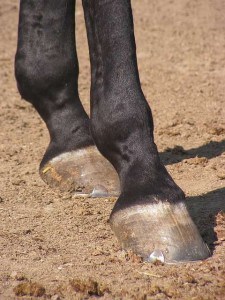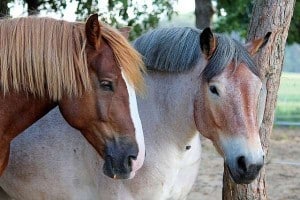Greasy heel or mud fever or pastern dermatitis is an inflammatory skin condition affecting horses.
It affects the lower limb, primarily the heel, ankle and sometimes spreads up to the knee.
Horses with non-pigmented skin and long hair are more predisposed to this disorder.
Environmental conditions or infections can cause this disease. Few of the causative factors include:
- Exposure to moist environments- wet beddings, muddy paddocks
- Insect bites at lower limbs
- Abrasions at the heel due to rough surfaces
- Prolonged exposure to sweat
- Sunburn in case of horses with white limbs
These conditions increase the susceptibility of the horse to infection by bacteria like Dermatophilous Congolensis and Staphylococcus.
The disease begins with mild skin irritation and swelling at the back of the pastern and proceeds into lesions causing scaling, crusting, and exudation.
If not controlled at
early stages, the infection can spread up the limb leading to trauma and lameness. Treatment for greasy heel generally involves keeping the affected area clean, softening the scabs and removing them and applying topical anti-microbial agents.
Prevention is the only remedy for this disease. Reduce the horse’s exposure to muddy and wet areas and keep the heels and limbs clean.
Please feel free to use the Table of Contents below to jump to the relevant section in the article.
Table of Contents
4 Ways Turmeric Benefits in the Greasy Heel / Mud Fever

Turmeric is a great natural painkiller with no side effects thus can help in effective pain management in the greasy heel.
Also, turmeric’s anti-microbial properties help to destroy the infection.
It helps build immunity and in repairing the damaged skin.
Turmeric is a popular spice used regularly in Asian cuisine.
Apart from adding flavour, this spice also has a number of health benefits.
Curcuminoids are a group of compounds that impart most of the pharmacological properties to turmeric. They are strong antioxidants and give the herb its golden yellow color. Curcumin is the principal curcuminoid that is researched widely for its medicinal value.
No research studies till date provide any evidence suggesting that turmeric can help in treating greasy heel / mud fever. But turmeric has a number of pharmacological properties which could be relevant in case of the greasy heel.
However, we would recommend consulting a vet before starting your horse on turmeric.
1. It can control inflammation and pain
Inflammation is a process comprising migration of immune cells and pro-inflammatory substances to the affected area.
In case of infection, this process helps in fighting the microbes but sometimes this reaction can be inappropriate.
Turmeric helps in controlling this reaction and thereby reduce pain and swelling. Turmeric exerts anti-inflammatory and analgesic effect by:
- Reducing immune responses and migration of immune cells to the injured site
- Reducing the production of inflammatory chemicals
- Reducing the activity of proteins like nuclear factor kappa B which regulate genes involved in inflammation.
Turmeric’s anti-inflammatory and analgesic activity is found to be better than painkillers like phenylbutazone, indomethacin and diclofenac sodium.
What does this mean?
Turmeric and its active constituents have anti-inflammatory that reduces pain, swelling and redness observed in greasy heel.
2. It acts as an anti-microbial agent
Turmeric is a proven natural anti-microbial agent. It acts against bacteria, viruses, fungi, and parasites. This property of turmeric can help in destroying infections occurring in the greasy heel / mud fever.
Turmeric oil has anti-fungal activity comparable to that of ketconazole, a commonly prescribed anti-fungal medication. Ar-tumerone, tumerone and curlone are the major compounds in turmeric oil that impart anti-microbial properties to the oil.
Experimental studies prove that turmeric’s anti-microbial activity is comparable to that of antibiotics. It can also help fight nasty infections that do not respond to any treatment by reversing drug resistance.
What does this mean?
Turmeric is as good as antibiotics in destroying infections.
3. It boosts immunity
Turmeric is an immunomodulatory agent- it can influence immune responses as desired. Low doses of curcumin boost the immune responses and help in fighting diseases and infections.
Conversely, at high doses, it can suppress immune responses and migration of immune cells. This helps in controlling inflammation, pain and tissue damage.
This dual action of turmeric potentiates its therapeutic effect in most disorders.
What does this mean?
Reduced immunity can make your horse susceptible to infections. Turmeric can enhance your horse’s immunity.
4. It can repair damaged skin

Curcumin protects the skin by scavenging chemical species that could cause oxidative damage to the tissue and reducing inflammation.
It also has skin regenerating and healing potential in case of wounds and burns. Curcuminoids, especially curcumin reduces allergic reaction and itching.
UV radiation causes oxidative damage to the skin. Extracts of turmeric have photoprotective and moisturizing properties which help in protecting against UV radiation-induced damage.
This can be of help to horses who have non-pigmented limbs and are susceptible to sunburns.
What does this mean?
Turmeric has the potential to heal scratches, wounds and lesions. It can also protect skin from damage by sun’s radiation.
Dosage
Turmeric can be included in your horse’s feed and this can help enhance his immunity and ward off infections. There is no set dosage of turmeric.
Mix a dessertspoon or 2 teaspoons of turmeric powder in 5-10 ml of coconut, olive or linseed oil and add 6-8 grinds of freshly ground black pepper. Add water and blend it into a paste.
Mix this paste with your horses’ feed. You can also cook the paste to enhance its effectiveness before adding it to the feed.
You can also cook this paste over the flame to make ‘Golden Paste’ and store the paste in the fridge.
In fact, you can use the same Golden Paste that you consume for your horse.
If you plan to prepare the paste for every feed then here is how to do it:
Take about 125 ml turmeric powder and add this with 250 ml water to a pan. Cook on low flame till you make a good paste.
Add the water slowly such that the paste is neither watery nor thick. You could add more turmeric powder if the paste is watery and more water if it is too thick.
Then add about 1 1/2 (7.5ml) teaspoon of freshly ground black pepper and 70 ml of oil. You could use coconut or olive or flaxseed oil.
Keep stirring till all the ingredients are mixed properly. Let the mixture cool down.
Start your horse with small doses on a regular basis and increase the dosage depending on the response. Most people give 1 teaspoon of turmeric twice a day. Avoid using oil if the feed is already rich in fats.
Also, remember to add plenty of water while giving the turmeric mix as horses find it more acceptable in that manner.
Turmeric can also help in other horse health issues –
Read – Turmeric benefits for Ringbone
Read – Turmeric benefits for Horse Arthritis
Read – Turmeric benefits for Equine Sarcoids
Read – Turmeric benefits for Laminitis
Precautions
No adverse effects should be observed by including turmeric in your horse’s feed. However, in case of an inappropriate dose or excess, gastrointestinal symptoms might occur. Discontinue turmeric from his feed then.
Also, avoid turmeric prior to surgical procedures to avoid the risk of bleeding.
Turmeric finds its use as herbal medicine in Trinidad and it is said to flush out the uterus. This could have implications on equine gestation and post partum health.
It would be best if you would consult a vet before starting your horse on turmeric.
Conclusion
As mentioned previously, there is no scientific evidence that supports the use of turmeric in the greasy heel / mud fever.
However greasy heel / mud fever is an inflammatory and infectious condition which suggests that turmeric’s anti-inflammatory and anti-microbial properties could be of help.
Also, turmeric has been used in treating skin conditions in animals and humans and this should hold true for your horse. With the help of a vet, start your horse on turmeric and do share your experience with us.

